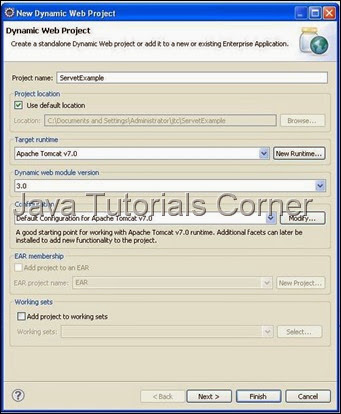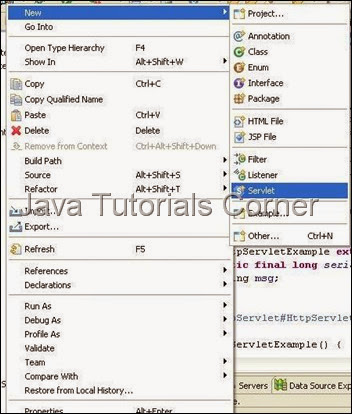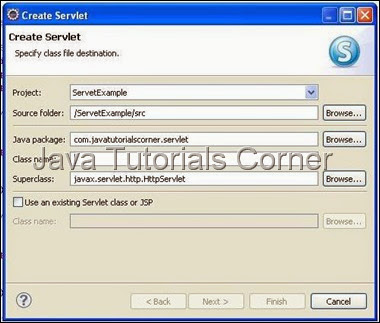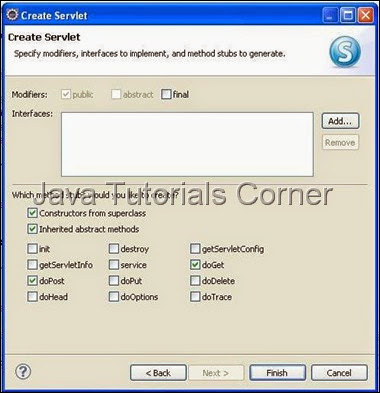In this tutorial we are going to see about, how to configure Log4j in web application.See more Log4j Examples
1. Create new Dynamic web project by choosing File –> New –> Dynamic Web Project .
2. Create the Project called ServletExample as given below.

3. Create package called com.javatutorialscorner.servlet under ServletExample.
4. Create following Servlet as shown in figure.


5. Click Next it will show URL mapping.You can edit Servlet URL if you need.
6. Click Next it will show methods available in HttpServlet. Select appropriate method you need.

7. By default your servlet will be mapped in web.xml, if your servlet not mapped in your web.xml use the following configuration to map the servlet in your web.xml
Servlet Mapping
web.xml
8.Add log4j-x.x.xx.jar in your build path.
9. Create log4j.xml in WEB-INF/classes/ folder
log4j.xml
10. Add the required code inside doGet() method.
Log4jServlet.java
HelloWorldServlet.java
11. Now save and Run the servlet, Run As –> Run on Server – Select your web Server to run the servlet. ( see How to configure tomcat in eclipse)
http://www.javatutorialcorner.com/2014/03/how-to-configure-tomcat-in-eclipse.html
12.call the URL which is mapped in web.xml. You can see the log message in log file and console.
http://localhost:8080/ServletExample/HelloWorld
Output
0 [http-bio-8080-exec-9] INFO com.javatutorialscorner.servlet.HelloWorld - Log4j Configured with Web application
1. Create new Dynamic web project by choosing File –> New –> Dynamic Web Project .
2. Create the Project called ServletExample as given below.

3. Create package called com.javatutorialscorner.servlet under ServletExample.
4. Create following Servlet as shown in figure.
- Log4jServlet.java
- HelloWorldServlet.java


5. Click Next it will show URL mapping.You can edit Servlet URL if you need.
6. Click Next it will show methods available in HttpServlet. Select appropriate method you need.

7. By default your servlet will be mapped in web.xml, if your servlet not mapped in your web.xml use the following configuration to map the servlet in your web.xml
Servlet Mapping
<servlet>
<servlet-name>Your Servlet Name</servlet-name>
<servlet-class>Fully Qulaified Servlet Class Name</servlet-class>
</servlet>
<servlet-mapping>
<servlet-name>Your Servlet Name</servlet-name>
<url-pattern>/URL to Call Servlet</url-pattern>
</servlet-mapping>
web.xml
<?xml version="1.0" encoding="UTF-8"?> <web-app xmlns:xsi="http://www.w3.org/2001/XMLSchema-instance" xmlns="http://java.sun.com/xml/ns/javaee" xmlns:web="http://java.sun.com/xml/ns/javaee/web-app_2_5.xsd" xsi:schemaLocation="http://java.sun.com/xml/ns/javaee http://java.sun.com/xml/ns/javaee/web-app_3_0.xsd" id="WebApp_ID" version="3.0"> <display-name>ServetExample</display-name> <welcome-file-list> <welcome-file>index.html</welcome-file> </welcome-file-list> <servlet> <servlet-name>Log4jServlet</servlet-name> <servlet-class>com.javatutorialscorner.servlet.Log4jServlet</servlet-class> <init-param> <param-name>log4j</param-name> <param-value>WEB-INF/classes/log4j.xml</param-value> </init-param> <load-on-startup>1</load-on-startup> </servlet> <servlet> <servlet-name>HelloWorld</servlet-name> <servlet-class>com.javatutorialscorner.servlet.HelloWorld</servlet-class> </servlet> <servlet-mapping> <servlet-name>HelloWorld</servlet-name> <url-pattern>/HelloWorld</url-pattern> </servlet-mapping> </web-app>
8.Add log4j-x.x.xx.jar in your build path.
9. Create log4j.xml in WEB-INF/classes/ folder
log4j.xml
<?xml version="1.0" encoding="UTF-8" ?>
<!DOCTYPE log4j:configuration SYSTEM "log4j.dtd">
<log4j:configuration xmlns:log4j='http://jakarta.apache.org/log4j/'>
<appender name="console" class="org.apache.log4j.ConsoleAppender">
<layout class="org.apache.log4j.PatternLayout">
<param name="ConversionPattern" value="%r [%t] %p %c %x - %m%n" />
</layout>
</appender>
<appender name="FILE" class="org.apache.log4j.FileAppender">
<param name="file" value="${user.home}/log.log" />
<param name="append" value="true" />
<layout class="org.apache.log4j.PatternLayout">
<param name="conversionPattern" value="%r [%t] %p %c %x - %m%n" />
</layout>
</appender>
<root>
<level value="DEBUG" />
<appender-ref ref="FILE" />
<appender-ref ref="console" />
</root>
</log4j:configuration>
10. Add the required code inside doGet() method.
Log4jServlet.java
package com.javatutorialscorner.servlet;
import java.io.IOException;
import javax.servlet.ServletConfig;
import javax.servlet.ServletException;
import javax.servlet.http.HttpServlet;
import javax.servlet.http.HttpServletRequest;
import javax.servlet.http.HttpServletResponse;
import org.apache.log4j.xml.DOMConfigurator;
/**
* Servlet implementation class Log4jServlet
*/
public class Log4jServlet extends HttpServlet {
private static final long serialVersionUID = 1L;
/**
* @see HttpServlet#HttpServlet()
*/
public Log4jServlet() {
super();
// TODO Auto-generated constructor stub
}
/**
* @see HttpServlet#doGet(HttpServletRequest request, HttpServletResponse
* response)
*/
protected void doGet(HttpServletRequest request,
HttpServletResponse response) throws ServletException, IOException {
// TODO Auto-generated method stub
try {
String appPath = getServletContext().getRealPath("/");
String filePath = getInitParameter("log4j");
if (filePath != null) {
DOMConfigurator.configure(appPath + filePath);
}
} catch (Exception e) {
// TODO: handle exception
e.printStackTrace();
}
}
/**
* @see HttpServlet#doPost(HttpServletRequest request, HttpServletResponse
* response)
*/
protected void doPost(HttpServletRequest request,
HttpServletResponse response) throws ServletException, IOException {
// TODO Auto-generated method stub
}
}
HelloWorldServlet.java
package com.javatutorialscorner.servlet;
import java.io.IOException;
import javax.servlet.ServletException;
import javax.servlet.http.HttpServlet;
import javax.servlet.http.HttpServletRequest;
import javax.servlet.http.HttpServletResponse;
import org.apache.log4j.Logger;
/**
* Servlet implementation class HelloWorld
*/
public class HelloWorld extends HttpServlet {
private static final long serialVersionUID = 1L;
private static final Logger log = Logger.getLogger(HelloWorld.class);
/**
* @see HttpServlet#HttpServlet()
*/
public HelloWorld() {
super();
// TODO Auto-generated constructor stub
}
/**
* @see HttpServlet#doGet(HttpServletRequest request, HttpServletResponse
* response)
*/
protected void doGet(HttpServletRequest request,
HttpServletResponse response) throws ServletException, IOException {
// TODO Auto-generated method stub
log.info("Log4j Configured with Web application");
}
/**
* @see HttpServlet#doPost(HttpServletRequest request, HttpServletResponse
* response)
*/
protected void doPost(HttpServletRequest request,
HttpServletResponse response) throws ServletException, IOException {
// TODO Auto-generated method stub
}
}
11. Now save and Run the servlet, Run As –> Run on Server – Select your web Server to run the servlet. ( see How to configure tomcat in eclipse)
http://www.javatutorialcorner.com/2014/03/how-to-configure-tomcat-in-eclipse.html
12.call the URL which is mapped in web.xml. You can see the log message in log file and console.
http://localhost:8080/ServletExample/HelloWorld
Output
0 [http-bio-8080-exec-9] INFO com.javatutorialscorner.servlet.HelloWorld - Log4j Configured with Web application





0 comments:
Post a Comment